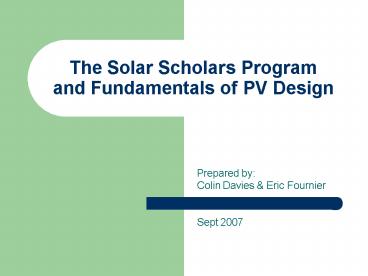The Solar Scholars Program and Fundamentals of PV Design PowerPoint PPT Presentation
1 / 30
Title: The Solar Scholars Program and Fundamentals of PV Design
1
The Solar Scholars Program and Fundamentals of
PV Design
- Prepared by
- Colin Davies Eric Fournier
- Sept 2007
2
Outline
- Renewable vs. non-renewable energy
- The science of photovoltaics
- Principle design elements
- System configurations
- The Solar Scholars program at Bucknell
3
Whats wrong with this picture?
- Pollution from burning fossil fuels leads to an
increase in greenhouse gases, acid rain, and the
degradation of public health.
- In 2005, the U.S. emitted 2,513,609 metric tons
of carbon dioxide, 10,340 metric tons of sulfur
dioxide, and 3,961 metric tons of nitrogen oxides
from its power plants.
4
Making the Change to Renewable Energy
- Solar
- Geothermal
- Wind
- Hydroelectric
5
Harnessing the Sun
- Commonly known as solar cells, photovoltaic (PV)
devices convert light energy into electrical
energy - PV cells are constructed with semiconductor
materials, usually silicon-based - The photovoltaic effect is the basic physical
process by which a PV cell converts sunlight into
electricity - When light shines on a PV cell, it may be
reflected, absorbed, or pass right through. But
only the absorbed light generates electricity.
6
The Science of Photovoltaics
- http//www1.eere.energy.gov/solar/video/solarcell1
.mpg
Source Olympus Microscopy Resource Center
7
Crystalline Structure
- Single Crystal Silicon Very efficient but
expensive manufacturing process
- A single seed crystal is place atop a crucible
of molten silicon. As this seed crystal is slowly
raised a large single crystal ingot is formed.
This ingot is then sliced into several sheets for
solar panel manufacturing.
Source U.S. Dept of Energy
8
Other options
- Multicrystalline Silicon Less efficient than
single crystalline silicon but also less
expensive to produce
- Amorphous Silicon Non-crystalline structure
(even less efficient) very inexpensive
depositional manufacturing process
9
Electricity Basics
- The power produced by solar arrays is in the form
of direct current or DC power.
- The outlets in our homes provide alternating
current (AC). - Questions?
10
Design Elements Going from DC to AC power
- The DC power generated by the array must first be
converted to AC before it can be used in the home
or sold back to the utility
- An Inverter converts DC power to AC power
11
Wiring
- Efficiency penalty associated with DC power over
long distances - AC line losses are minimal
- Resistance depends on conductor gauge, length,
material, and temperature
12
Getting Desired Voltage and Amperage
- Series Voltages are additive, current is equal
- Parallel Currents are additive, voltage remains
the same
13
IV Curve - MPP
Power (Watts) Current (Amps) X Voltage (Volts)
14
IV Curve Cell Temp Irradiance Response
15
Site Selection - Shading
- Shading effects important to site selection
- Orientation of shaded region on module is
critical to output
16
Site Selection Panel Direction
- Face south
- Correct for magnetic declination
17
Site Selection Tilt Angle
Max performance is achieved when panels are
perpendicular to the suns rays
- Year round tilt latitude
- Winter 15 lat.
- Summer 15 lat.
18
Mounting Options
- Fixed
- Roof, ground, pole
- Integrated
- Tracking
- Pole (active passive)
19
Configurations
- Grid-tied
- Grid-tied with battery backup
- Stand-alone
20
Grid-tied
- When grid goes down, you also lose power
- Excess power can be sold to grid
- Electricity can be bought from grid at night or
on cloudy days
21
Grid-tied with battery backup
- More independence
- Batteries add complexity and cost
22
Stand-alone
- Remote locations
- Road-side
23
Energy Consumption
- Air conditioner (1 ton) 1500W
- Blow dryer ....... 1000W
- Refrigerator/freezer (22 ft3) .. 540W
- Washing Machine ...... 1450W
- Incandescent light (75W) .. 75W
- Compact fluorescent (75W equiv.) .. 20W
- Cell phone charger .... 24W
Avg U.S. home 25 30 kWh per day
24
Energy Efficiency
- Home energy audit
- Insulation, windows
- Compact fluorescent lights
- Appliances
- Phantom loads
- 45 billion kWh annually
- 3.5 billion per year
- 10 power plants
- 18,000,000 tons of CO2
- More pollution than 6 million cars
- TVs and VCRs alone cost the US 1 billion per
year in lost electricity
25
Solar Scholars Overview
- Solar Scholars is an innovative, solar-energy
education program for university students
throughout Pennsylvania, created by The
Sustainable Energy Fund of Central-Eastern
Pennsylvania (The SEF-CEPA). - Its goal is cultivating the solar and renewable
energy leaders, policy-makers and entrepreneurs
of tomorrow.
26
Solar Scholars Workshop
27
BUEC Installation
- Twelve 200 W GE panels (2.4kW)
- Ground mounted
- Fronius Inverter with Datalogger
- Grid-tied
28
Mod Installation
- Two pole mounted arrays Eight 200 W GE panels
per pole (3.2kW total) - Fixed
- Passive tracker
- Two Fronius Inverters
- Grid-tied
29
Mod Installation (cont)
All in a good days work
30
Ready for a field tour?
- Questions?
- If you are interested in anything you have seen
today and would like to get involved, please
contact any member of the Solar Scholars team - Colin Davies, Eric Fournier, or Jess Scott
- (cjdavies, efournie, jpscott)

